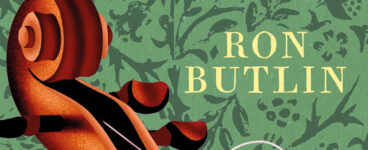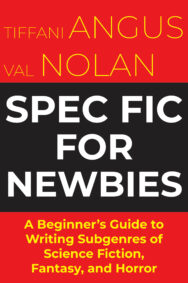‘The latter half of the twentieth century began to see the dominance of women writers in the dystopian mode, something that should not surprise anyone, and that ascendency continues today.’
This new anthology of essays from Luna Press introduces the broad genre of speculative fiction, exploring its sub-genres across science-fiction, horror and fantasy and offering useful advice for any would-be authors or critics. Dive in and learn all about dystopias in the extract below!
Spec Fic for Newbies
By Tiffani Angus and Val Nolan
Published by Luna Press Publishing
DYSTOPIA
More than simply the opposite of Utopia, dystopias have evolved into a fertile subgenre of their own. They are a worst-case scenario; they are a warning; they are an arena for resistance. They generate a sense of dread by expressing our fears regarding loss of agency and individuality. You want to write about them? Well, you’re not allowed! The government, religious authorities, warlords, corporate executives, or algorithms forbid it! And yet….
A Short History of Dystopia
One of the earliest uses of the word dystopia was by political economist John Stuart Mill in 1868 when he lambasted British policy towards Ireland as ‘Dystopian’ and ‘too bad to be practicable’ (these were, after all, the people who had overseen the Irish Famine twenty years earlier).1 Old-school examples of fictional dystopias include Walter Besant’s The Inner House (1888) and Jack London’s The Iron Heel (1907), but for the good bad stuff one needs to wait for the ‘terrors of the twentieth century’, in particular the devastation of World War I, which made it difficult for people to imagine better futures.2 A typical narrative pattern quickly developed that is still visible today in SF stories about ‘the oppression of the majority by a ruling elite’ and ‘the regimentation of society as a whole’.3 We see this in a series of typical tropes such as ‘the lack of freedom, the constant surveillance, the routine, the failed escape attempt […] and an underground movement’.4 A further important observation is that ‘unlike the “tourist” style narration common to utopias, Dystopias tend to be narrated from the perspective of the imagined society’s inhabitant; someone whose subjectivity has been shaped by that society’s historical conditions, structural arrangements, and forms of life’.5
Some of the subgenre’s most influential and oft-imitated texts emerged in the middle decades of the century. The first of these is Aldous Huxley’s Brave New World (1932), the flavour of which is discernible in everything from The Matrix (dir. the Wachowskis, 1999) to contemporary conservative politics. Brave New World is a tapestry of anxieties over mass production and overpopulation, personal and psychological freedom, eugenics, commodification, and technocratic government control. Huxley presents a world state in which people are grown artificially in vast municipal incubators, are sorted based on intelligence and labour requirements, and are addicted to hedonism in a way that anticipates the short cycle dopamine hits of today’s social media and our commercial gamification of sexuality via dating apps and television shows such as Love Island. Did Huxley predict our present? If he did, he did so just ahead of George Orwell with Nineteen Eighty-Four (1949), a novel in which austerity dominates a Britain known as ‘Airstrip One’, a society under mass surveillance where cameras are omnipresent but independent thought and self expression are crimes. Orwell’s totalitarian government warps language in a manner that popularised many key pieces of dystopian imagery and terminology such as ‘Big Brother’ (not the reality show, but that’s where the name comes from!), ‘Thought Police’, and ‘Memory Hole’. A third book, the darkly satirical A Clockwork Orange (1962) by Anthony Burgess, also plays with language (in this case a mishmash of Slavic words and Cockney rhyming slang) in its construction of an ironic and dystopian Britain stalked by gangs of violent delinquents. The novel interrogates notions of personal and state violence but is best known for its depiction of behaviour modifications that have inspired any number of brainwashing scenes in dystopian literature, television, and cinema.
The latter half of the twentieth century began to see the dominance of women writers in the dystopian mode, something that should not surprise anyone, and that ascendency continues today. James Tiptree, Jr. (Alice Sheldon)’s Hugo Award-winning The Girl Who Was Plugged In (1973) explores ‘the traumatic appropriation of the human body’ along with questions about ‘oppressive consumer culture and corporate technoscience’ that still speak to our present moment of influencers and YouTube personalities.6 Dominating this period of dystopian fiction, however, is Margret Atwood’s seminal novel The Handmaid’s Tale (1985) set in an authoritarian future America governed by a religious hard right that forcibly subjugates women’s reproductive autonomy. Atwood’s great achievement was tying her dystopia into America’s long Puritanical tradition (such as the Salem witch trials) and the political climate at the time during which it was written, thus making her fictional future feel historically persuasive.7 She’s made no secret about the real-world relevance of her novel, stating that her primary inspirations were ‘what some people said they would do re: women if they had the power (they have it now and they are)’.8 The result is a bleak, uncompromising, and socio-historically resonant fiction that remains the gold standard for literary dystopias.
The work of Tiptree and Atwood continues to cast a long shadow, and any representative sample of contemporary dystopian fiction proudly displays their influence. Such books include Suzanne Collins’s hugely popular Hunger Games trilogy (2008–’10); Hillary Jordan’s When She Woke (2011), which is a science fictional re-telling of Nathaniel Hawthorne’s The Scarlet Letter (1850); Louise O’Neill’s Only Ever Yours (2014) in which women are no longer born but made to order; Meg Elison’s The Book of the Unnamed Midwife (2014) in which the surviving women of a post plague world are sexually enslaved by violent men; Claire Vaye Watkins’s timely climate dystopia Gold Fame Citrus (2015); and so on. Yet while all these fictional dystopias are generally a step or two removed from the real world, they are often only set ‘ten minutes into the future of technoscientific innovation’ and as such offer a negative version of a reality already riddled with inequality and violence.9 That said, they frequently contain within them the possibility for change, which we as writers might think of as the ‘story’. Even The Handmaid’s Tale concludes with metafictional ‘Historical Notes’ taking place further in the future again, something that retroactively positions that dystopia as poised between the timeframe of the reader and the possibility—the hope—of a better future to come.
1. Hansard Commons, 12 Mar. 1868, vol. 190.
2. Moylan, 2000, p. xi.
3. Stableford, ‘Dystopias’, 2021. n.p.
4. Ketterer, 1989, p. 211.
5. Davison-Vecchione, 2021, n.p.
6. San Miguel, 2018, p. 29.
7. Regalado, 2019, n.p.
8. Temple, 2017, n.p.
9. San Miguel, 2018, p. 36.
Spec Fic for Newbies by Tiffani Angus and Val Nolan is published by Luna Press Publishing, priced £16.99.
ALSO IN THIS ISSUE

 So Many Lives and All of Them are Yours: A Q&A with Ron Butlin
So Many Lives and All of Them are Yours: A Q&A with Ron Butlin
‘Music helps me keep my life on track. It teaches me how to structure my work, to develop form and n …

 Across the Silent Sea
Across the Silent Sea
‘I’m losing my way, forgetting how to do things for myself. Sometimes I don’t have the motivation to …













